Helping with Exam Anxiety
- Anxiety is a feeling of unease such as fear or worry. It’s one of the body’s natural responses to stress and affects our thoughts, feelings, body, and behaviour.
- Anxiety is a natural response to everyday difficulties. It’s normal for young people to feel anxious about certain things – just as it’s normal for parents and carers to worry about their child
- Most young people who are experiencing anxiety don’t require specialist help. There is a lot of what you will already do that will be really helpful
- Normalising anxiety, helping your child to understand their own anxious feelings, as well as providing support and encouragement, can make a big difference.
- Anxiety is not necessarily a mental health condition. Most of the time, anxious feelings are normal responses to stressful situations in everyday life, and they will pass naturally.
Mental Health Continuum
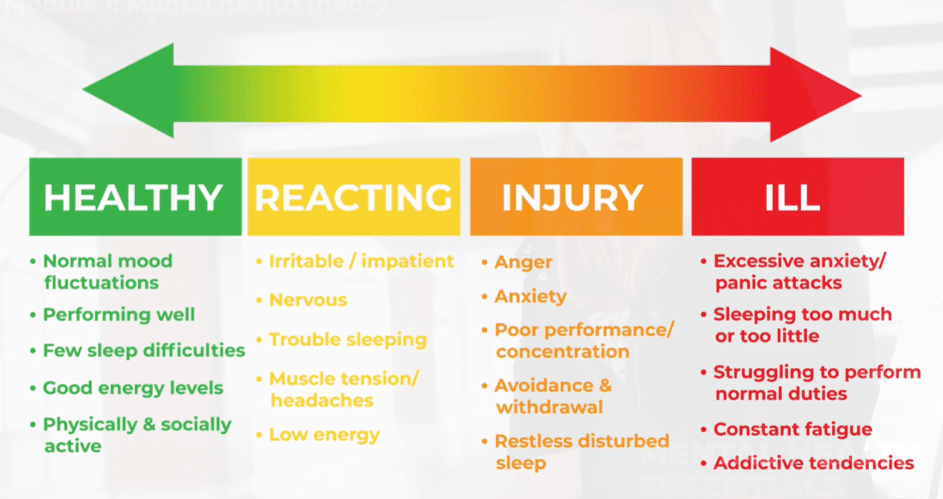
Common Signs of Anxiety
Thoughts
- preoccupied by upsetting, scary or negative thoughts
- worrying a lot about things that may happen in the future
- worrying about not being able to cope with daily things like school and friendships
Feelings
- nervous, on edge, panicky or frightened
- overwhelmed or out of control
- full of dread or an impending sense of doom
Physical Signs
- feeling sick
- feeling tense, fidgety or restless
- feeling hot or sweaty
- taking short, shallow breaths
- feeling shaky – for example, like you have wobbly legs
- having trouble sleeping
- finding it difficult to concentrate
- feeling more sensitive to noises, smells or sights around you
- having diarrhoea or needing to pee more than usual
- having panic attacks, which can include a racing heart, breathing very quickly and feeling unable to breathe
Behaviours and Coping Mechanisms
- withdrawing or isolating themselves – including not wanting to go to school or be away from parents or carers (sometimes called ‘separation anxiety’)
- avoiding social situations (sometimes called ‘social anxiety’)
- being more irritable or angry, or acting out
- repeating certain behaviours, actions or rituals, or repetitively seeking reassurance (this can be a sign of an anxiety-related condition called Obsessive-Compulsive Disorder or OCD
- eating more or less than usual
- self-harming
When does Anxiety become a concern?
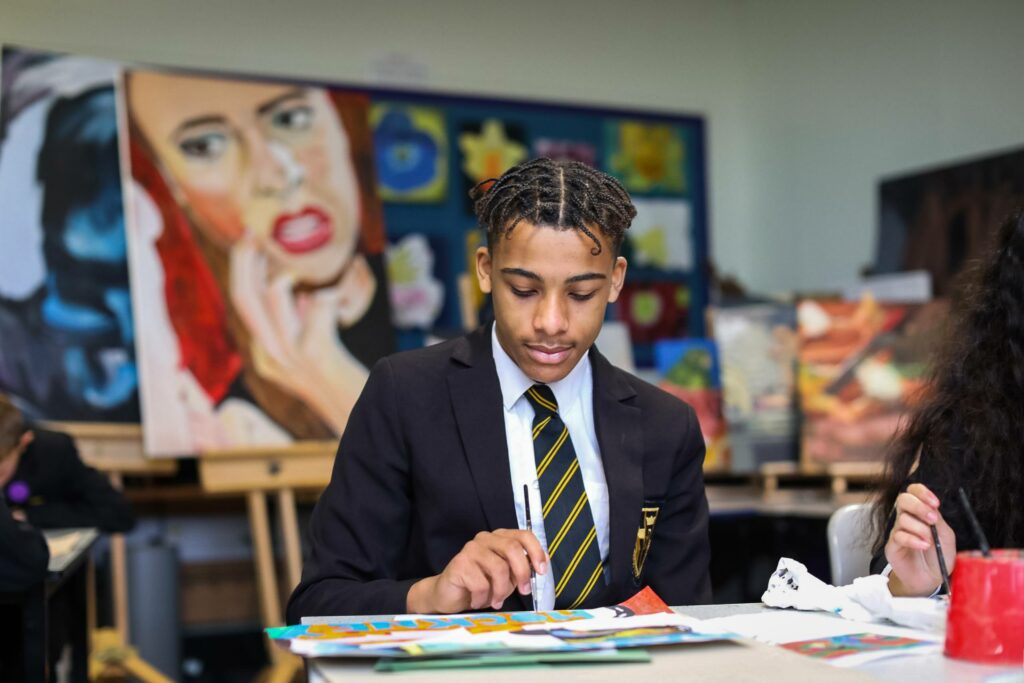
- It is constant and overwhelming
- It occurs in response to no real threat or if the threat is exaggerated
- It interferes with your child’s daily life
- It stops your child doing what they want to do
Strategies to support your child
Listen
Ask them about how they feel and ask them to be open and honest with you. Let them talk and listen to what they say. Try to avoid telling them to ‘calm down’ or ‘relax’
Normalise
Explain to your child that anxiety if a normal response to everyday difficulties. Explain that you are there to support them. Talk to them about the anxiety alarm analogy.
Structure/Routine
A consistent routine around wake up time, bed time, meal times, phone usage, school work and other elements of their life is proven to help. Make your child aware of any upcoming changes to that routine so that they have time to adapt.
Practice Coping Skills
Identify what works best for your child and practice these coping strategies with them. You might want to write them down and leave them around the house if your child needs them, or encourage your child to carry a copy of them
Mindfulness Techniques
Breathe slowly and deeply together
Together, hold your hands out in front of you. Trace the outline of each of your fingers slowly with your other hand. Breathe in as you go up each finger, and out as you come down. Move and breathe as slowly as feels comfortable. Over time, encourage your child or young person to breathe out for one or two counts longer than they breathe in. This can help their body to relax.
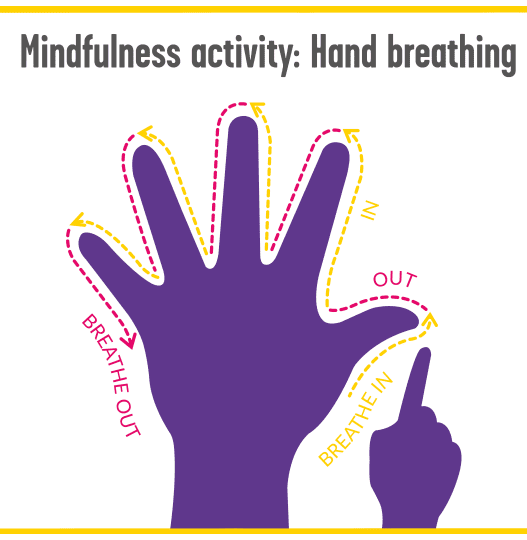
Use all 5 senses together
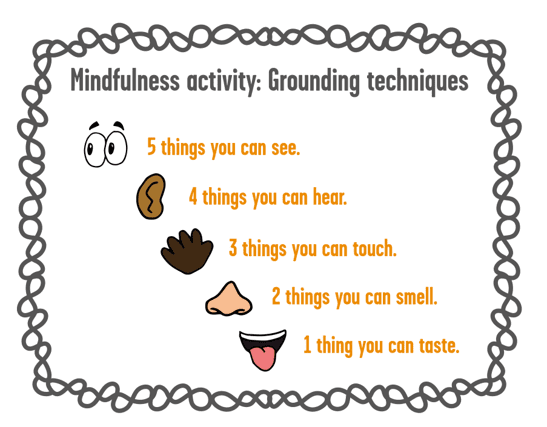
Connecting with what we can see, touch, hear, smell and taste is sometimes called ‘grounding’. Doing grounding techniques can make us feel more present and bring us back into our body. This can reduce the intensity of our anxiety. Think together about what they can see, touch, hear, smell and taste.
For example, they might notice: five different colours; four soft things in the room; three sounds like cars going past the window or the noise of the washing machine; two things they can smell, like a scented candle or a piece of fruit; and one thing they find soothing to eat.
Use a stress bucket
A stress bucket is a visual way communicate your anxiety. Here’s how your child can use them –
- Above the bucket are taps and the things that cause you stress. Using the boxes, draw or write the things that are making you worry. It might be too much homework, friendship issues, exam anxiety.
- The below taps are the things that help you release stress. Using these boxes, write or draw the things that help you manage this feeling, such as seeing friends, exercise or spending time with family.
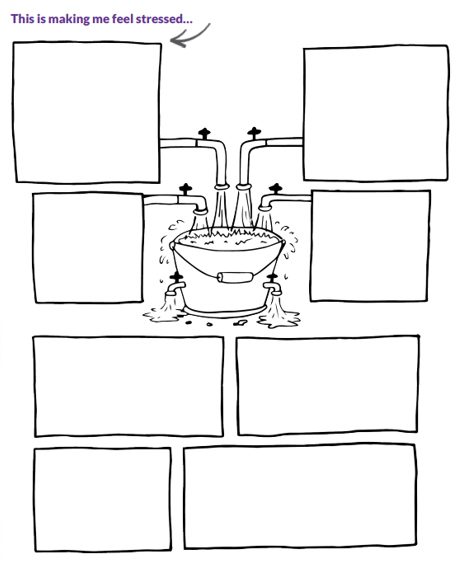
It can also help to…
Sit with them and offer calm reassurance.
Feeling you nearby can be soothing. If it helps, hold their hand, put your arms around them. If this is too much, just sit near them. Reassure them the anxiety will pass and they will be okay. It can help to describe it as a wave they can ride or surf with you support until peaks, breaks and gets smaller.
Ask them to think of a safe place or person.
If you haven’t tried this before, agree when they’re feeling calm what this is. It could be their bedroom, a favourite place in nature or somewhere they’ve been on holiday. Sometimes holding a memento of a relaxing place, like a seashell or pebble, can help.
Encourage them to do an activity that helps them feel calmer.
This could be running, walking, listening to music, painting, drawing or colouring-in, writing a journal, watching a favourite film or reading a favourite book.
Remember, you don’t need to do all of these things each time. Everyone is different, and it’s about figuring out which of these strategies suits them best.
After they have calmed down, it can help to remind them that the panicky feeling did not last forever. They were able to do things that helped and the feeling stopped.
Further Resources
- NHS: Anxiety in Children (https://www.nhs.uk/every-mind-matters/)
- Youth Access (https://www.youthaccess.org.uk/)
- Young Minds (https://www.youngminds.org.uk/)
- Kooth (https://www.kooth.com/)
- School – we are happy to help; please let us know if your child is struggling






